|
| The Inner Core |
| Introduction to the Inner Core
Jackie Brand
This article is about inner core strength. You have seen the advertisements, "Abs of Steel" for example, all those perfect bodies with their "six-pack" abs. In this article I am not focusing on appearance, but on function, core stability, and on true strength. I am not saying that a "six pack" is not desirable, on the contrary, but I will be focusing on is that true strength and fitness are built below the surface, in the deep, powerful muscles of the inner core.
When you move, your body depends on certain core muscles to hold you steady while other muscles actually move your body. These core muscles lie deep within the trunk of the body and generally attached to the spine, pelvis and muscles that support the scapula. If your core muscles are strong and fire in the proper sequence, your posture is better, you are balanced, and you are less likely to be injured. When the core is weak, this can result in injuries such as a twisted knee, a pulled shoulder or back pain, otherwise known as a "bad back". A weak core can make you look and feel older than your years. For exercise at any level, core stabilization is essential for injury prevention and maximum fitness results.

We are all familiar with the form of the human skeleton. Take a look between the rib cage and the pelvis. Only the small spinal vertebrae are there to support your midsection. You must rely on muscles for protection and support. Failing to keep these muscles strong will result in injuries and chronic back pain. Pregnancy, childbirth, or even a few days of back pain can knock your core muscles completely out of commission. Retraining your core properly after a traumatic event can make a huge difference in your recovery.
The core in general is all the muscles of your torso. If you were to remove your head, arms and legs, that is your core. Let's take a look at a few the muscles of the core. I am going to put them into two different categories, the outer and inner core. The outer core in general are considered "movement" core muscles, and the inner core are considered "stabilization" core muscles. To note: all core muscles are used for stabilization for the outer limbs. Core muscles work together to keep your trunk stable while your limbs are active.
Outer Core: Rectus Abdominis (six-pack), External and Internal Obliques, Latissimus dorsi (back), Gluteus Maximus, ...to name a few.
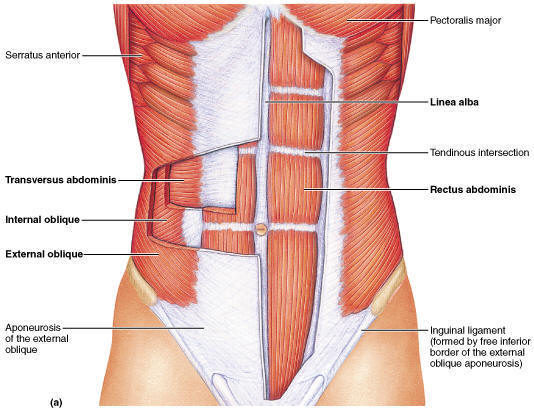
Rectus Abdominis- When fully developed, the rectus abdominis is the most prominent abdominal muscle. When you see a six pack, this is the muscle you're seeing. It runs the length of your ab area, from your pubic bone to the lower chest. Contraction of this muscle flexes your torso. The rectus abdominis is the primary muscle involved when you do Crunches and Reverse Crunches. Although you hear the terms upper and lower abs, it's really just one muscle. You can emphasize the upper or lower section depending on which end of the muscle is moving. If your torso is moving towards your hips (Crunches) you're focusing on the upper abs. If your hips are moving towards your torso (Reverse Crunches), you'll focus on the lower section.
Internal and External Obliques: The internal obliques lie underneath the external obliques and run in a diagonally opposite direction to eachother. The internal obliques work with the externals to rotate the trunk. The obliques also compress the abdomen when both sides contract. The external obliques are visible when fully developed unlike the internal obliques which are not visible when fully developed.
Latissimus dorsi: widest and most powerful muscle of the back. It is a large, flat, triangular muscle covering the lower back. It arises from the lower half of the vertebral column and iliac crest (hipbone) and tapers to a rounded tendon inserted at (attached to) the front of the upper part of the humerus (upper-arm bone). The latissimus dorsi draws the upper arm downward and backward and rotates it inward, as exemplified in the downstroke in swimming the crawl. In climbing it joins with the abdominal and pectoral muscles to pull the trunk upward. The two latissimus dorsi muscles also assist in forced respiration by raising the lower ribs.
Gluteus maximus: You don't have to look too far for this body part, you're sitting on it. The Gluteus maximus is the biggest muscle in the human body. The gluteus maximus forms the bulk of the buttocks. It acts to extend the upper leg, spread it, and turn it outward.
Inner Core: Transverse Abdominis, Pelvic Floor, Multifidus
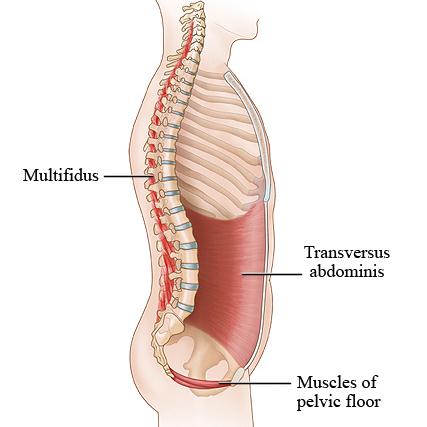
Transverse abdominis: Are the largest, deepest abdominal muscles. It makes up the sides, and parts of the front and back of your trunk. This muscle forms a corset around the body and acts as your body's natural back belt. It attaches to your ribs, pelvis, and dense soft tissue on the back. The transverse abdominals pull your stomach and sides in toward your spine and upward toward your head. When sucking in your gut, to fit into a tight pair of jeans, you are using your transverse abdominis.
Pelvic Floor: Are a group of muscles that are shaped like a hammock and form the floor of the pelvis. This hammock extends from the tailbone to the pubic bone. By contracting the pelvic floor, the three joints of your pelvis (two sacroiliac joints, one pubic joint) are stabilized. I was once asked by a client to name the muscles of the pelvic floor, okay I think I got them here: The pelvic floor is composed of muscles fibers of the levator ani (3 parts-pubococcygeus, puborectolis and iliococcygeus) the coccygeus and connective tissue which span the area underneath the pelvis. Your pelvis floor is used when starting and stopping the flow of urine.
Multifidus: deep muscles that work from behind, weaving their way up the vertebrae (spine) to support and stabilize the spine itself.
Traditional fitness exercises and sports target your outer core, the muscles just below the surface of the skin. These exercises include crunches, Lat pull downs, leg lifts (Captains chair), Roman chair, back extensions, lunges, this list goes on and on, including most all the machines on the floor of the gym. This outer core strength is important; however, if these muscles are not supported by a strong foundation, they will likely overcompensate, resulting in acute or chronic pain and dysfunction. In order for your core to become a stabilizing force, strength training must begin with the inner core.
Timing is everything!
Proper muscle firing sequence is the key. Before you ever move your arm, your transverse abdominals (inner core) fire about 50 mili-seconds before the main movement starts. This preactivation set the core and allows arm or leg movements to occur without too much movement in the trunk and back. If this muscle is slow to fire or dose not fire at all, it means every time you move, your back suffers mico-trauma. Every time you move, thousands of times per day, too much motion occurs in the back. This sets the stage for instability, creating excessive loads and contributing to wear, tear and pain. What is the cause of this improper muscle firing? There are many causes, here are a few, pregnancy, childbirth, trauma, illness, and non use of the muscles, meaning we sit too much. The good news is, if there is a problem, this timing delay can be corrected.
How to exercise the inner core:
These muscles are not strong enough, even when pre-activated, to control a direction of movement. They are not strong enough to take a load. Their job is simple: fire quickly (before the main action) and prevent movement and stabilize. You cannot "power" your way to a strong inner core.
Exercises:
Drawing in Maneuver: On your hands and knees, pull in the region just below the naval toward the spine. Hold in for 15 seconds and release. 10 repetitions. The draw in maneuver can be done in any position, and performed during core and other exercises.
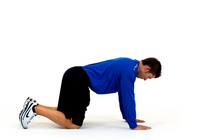
Marching: Lie on your back with feet flat on floor, hip width apart. Draw in maneuver. Keeping your pelvis and lower back stationary, lift both feet off the floor keeping the knees bent. Alternating sides, lower one foot at a time to the floor, as if marching. Repeat 10-15 times. Stop if you feel any discomfort in your lower back.
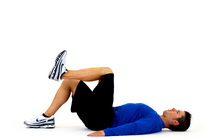 Gentle Spinal Twist: Lie on your back, knees bent, with your feet flat on the floor, arm out to each side to form a "T". Draw in maneuver, dropping both knees together to one side keeping the back as flat as you can against the floor, bring the knees back to center, repeat on other side. Repeat 10-15 times. If you feel any back pain "stop".
Gentle Spinal Twist: Lie on your back, knees bent, with your feet flat on the floor, arm out to each side to form a "T". Draw in maneuver, dropping both knees together to one side keeping the back as flat as you can against the floor, bring the knees back to center, repeat on other side. Repeat 10-15 times. If you feel any back pain "stop".
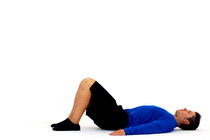
Floor Bridge: Lie on your back with knees bent ,feet on the floor shoulder width apart, place arms at side palms up. Draw in maneuver, lift pelvis off the floor until the knees, hips and shoulders are in line, tighten glutes. Slowly lower pelvis to the floor and repeat 10 times.
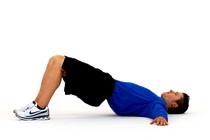
Quadruped Opposite Arm/Leg Raise (Bird Dog): Start on all fours (hands and knees). Draw in maneuver, and tuck in chin. Slowly raise the right arm (thumb up) and the left leg. Keep both arm and leg straight. Hold for 5 to 10 seconds, and repeat on other side. 5 repetitions on each side.
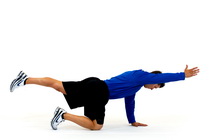
Prone Iso-ab (Plank): Lie prone (face down) on the floor. Draw in Maneuver, lift the entire body on the toes and elbows(forearms) to make a straight line, tighten glutes. Start with 5 to 10 second hold, and build up to one minute or more.
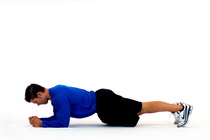
Finding and Working the Pelvic Floor: The easiest way to find the pelvic floor is to contract the muscles that stop the flow of urine, or the muscles that keep you from passing gas. Sit on a chair and try to lift the muscles of your pelvic floor away from the chair. People commonly contract the muscles of the buttocks and upper leg by accident while learning to isolate the pelvic floor. Do not let this happen, and remember to keep breathing. Once you learn how this can be done anywhere. Try to work this a few times each day.
References:
C.Jull, C. Richardson. Motor control problems in patients with spinal pain. Journal of Manipulative and Physiological Therapeutics, Volume 23 . Issuee, pages 115-117
Lee, D. (1999) The Pelvic Girdle, Second Edition. New York: Churchill Livingstone.
N.A.S.M. Optimum Performance Training, Second Edition 2004 National Academy of Sports Medicine, Calabasas CA. Exercise photos
Woods, N. SLIERS " Inner Core" patient education handout. Boise, Idaho 2004
Platero, J. The Power of Personal Training, N.C.C.P.T. Newbury Park CA 2000
 |
|










